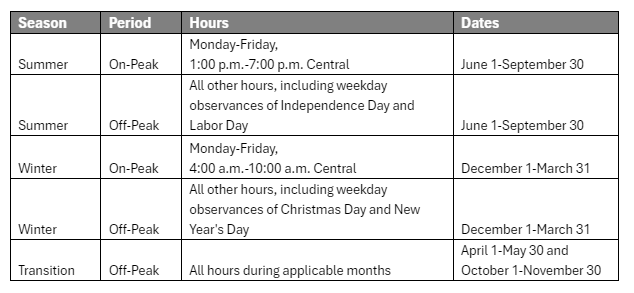Tips to Maximize Your Time-of-Use Rate Strategy
Enrollment for MLGW’s voluntary Time-of-Use electric rate currently is limited to pilot participants, whose electric charges are manually calculated each month. Once the TOU rate is programmed into our billing system, we will open enrollment to other interested customers. In the meantime, this webpage can help all residential customers better understand on-peak and off-peak hours. Reducing electricity use during on-peak hours means TVA does not need to build and operate higher-cost generation assets or purchase higher-cost electricity on the market, which helps control electricity costs for everyone.
Residential customers with electric smart meters enrolled in the voluntary Time-of-Use (TOU) rate can increase their savings by “load shifting,” which simply means delaying some electricity use until off-peak hours. With load shifting, you still use the same amount of electricity to perform the same tasks, but the cost of that electricity is less since you use it during periods of low demand. No one expects you to stop using electricity completely during peak periods—that would be near impossible—but the voluntary Time-of-Use rate can motivate your household to pay closer attention to when you use electricity and for what purposes. Since 88% of hours in the year are low-cost, off-peak times, you have plenty of options for saving. And contrary to popular rumors, TOU will not force you do laundry at 2:00am! (You can, of course, but it’s not necessary to achieve savings.)

There are many ways to “shift” electric load at your home. Find options in the list below and start with your largest electric load for the biggest impact. (Look for the wattage listed on the equipment. The higher the wattage, the larger the impact.)
- Run your dishwasher after 7:00pm on Summer weekdays and anytime on Summer weekends. In Winter, don’t run between 4:00am and 10:00am weekdays. The dishes still get clean and it costs you less to run the dishwasher. Try this trick: run your dishwasher just before bedtime and you’ll wake up with clean dishes! (Many dishwashers have a “delay” button, which enables you to set the machine but delays when the cycle begins. Check your owner’s manual or manufacturer’s website for information on using this feature to your money-saving advantage.)
- Tackle laundry during off-peak hours. The washing machine itself doesn’t require much electricity to operate, but your electric clothes dryer really does! (If you have an electric water heater and use hot water for washing, that also adds to on-peak costs.) Delaying use until off-peak hours not only cuts the operating cost but also delays the heat and humidity generated by your clothes dryer, so you will lower the need for cooling. Follow the same advice for using your clothes steamer and iron too.
- Run your swimming pool pump and heater during off-peak hours. In the Summer, that means before 1:00pm and after 7:00pm on weekdays, plus any hour on the weekend. Most equipment has a timer to automate your schedule for convenience—and savings.
- Operate your hot tub pump and heater during off-peak hours. In the Summer, that means before 1:00pm and after 7:00pm on weekdays, but you can go wild all weekend long when off-peak prices are in effect.
- Delay house cleaning chores until off-peaks hours. Your vacuum cleaner won’t know—or care—that you’re using discounted electricity!
- Limit your hot water use during on-peak hours if you have an electric water heater. (About 40% of local homes use electricity to heat water.) While you may not be able to delay bathing, you can postpone other hot water uses—including laundry and dishwashing—until off-peak hours on weekdays.
- Stop air conditioning an empty house! If you have not yet adopted an energy conservation strategy to raise your thermostat setting in the Summer when no one is home, now is the time to do it and you’ll benefit from decreasing your electric use during expensive on-peak hours. A thermostat setting of 78 degrees is recommended when people are home, so try 80 to 85 degrees if no one is home. (Yes, you need to consider pets, plants and fine oil paintings, but there are savings for everyone. Really.)
- Cool your occupied house during off-peak hours. If someone is home all day, try a “pre-cooling” strategy to maintain comfort while minimizing on-peak electricity use. Lower the thermostat so the house gets colder than usual in the morning, then raise it so the AC runs less from 1:00pm to 7:00pm weekdays. Keep the blinds and drapes closed to help block out the hot sun. A well-insulated home may be able to maintain its pre-cooled temperature for most of the afternoon. Ceiling fans and portable fans can help provide lower-cost supplemental cooling during on-peak hours.
- Take control of your heating costs! Although about 80% of homes in Shelby County have natural gas heat, electricity is required to run the fan that distributes heat. If your home has all-electric heat, this tip is even more important. Change your heating strategy to minimize operation during on-peak hours (weekdays, 4:00am to 10:00am during Winter). Get creative—try setting your programmable thermostat to run the furnace from 3:00am to 4:00am til the temperature gets toasty warm, then leave it off (or set to 50 degrees or so) until you get home from work. If someone is home all day, set the thermostat to increase the indoor temperature after 10:00am.
- Install a programmable thermostat—and then program it to operate automatically based on your household’s schedule and energy efficiency preferences. Program the system to turn off about 30 minutes before the last person leaves and then to turn on about 30 minutes before the first person gets home. Some newer programmable thermostats have a “recovery setting” instead, so read your owner’s manual carefully.
- Teach your family to use the water and ice dispenser on the refrigerator door instead of opening the fridge or freezer to fill the glass. Doing this will help delay compressor run times to re-cool the air in your fridge and freezer compartments.
Challenge your family to see how much load shifting you can accomplish. You’ll be more aware of electricity use and, by reducing the amount of electricity that is needed, you can help the planet through lower emissions from power plants. If you also enroll in the Time-of-Use rate, these strategies will help save money.
| Even if you don’t adopt the optional Time-of-Use rate, you can still help lower the area’s peak power demand by following these easy tips. Remember, MLGW's power generator (TVA) must build and operate power plants or buy market-priced electricity based on total peak demand at any moment—so every step from every customer can help lower that total, which helps control electricity rates for everyone. |


